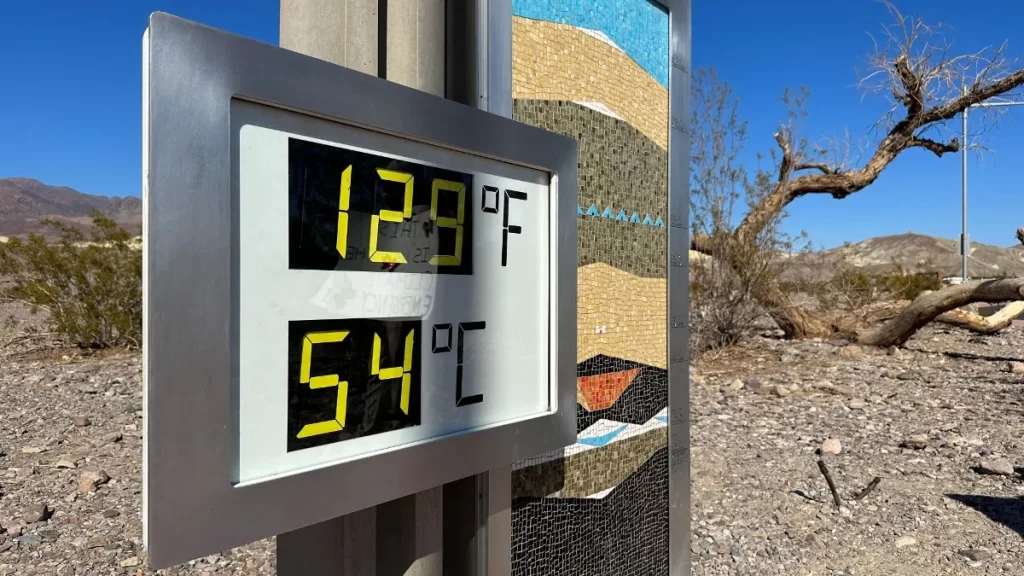Navigating the Challenges of California Heat Wave Temperatures

California, a state known for its diverse climate and beautiful landscapes, has been experiencing unprecedented heat waves in recent years. These heat waves, characterized by extreme temperatures, have significant implications for the environment, public health, and daily life. Understanding the patterns, impacts, and measures to cope with such extreme weather is crucial for residents and policymakers alike. This article delves into the various aspects of California heat wave temperatures, providing a comprehensive overview of the situation and offering insights on how to mitigate its effects.
The Science Behind Heat Waves
Heat waves are prolonged periods of exceptionally warm weather, sometimes lasting days or weeks. Extremes such as this are associated with numerous meteorological variables, like high-pressure air systems that restrict cooler air from moving into an area. California’s valleys and coastal ranges compound the effects of heat waves in California by trapping these high pressure systems in a region. Global climate change is implicated in the increasing frequency and severity of heat waves as well. The concentration of greenhouse gases in Earth’s atmosphere causes the absorbtion of more heat, warming the overall climate.
Familiarity with this science helps however to predict the arrival of heatwaves and be prepared for their impact.By predicting the weather that causes heat waves through the use of meteorological models, combined with data collected over several years by local weather stations, specialists are able to issue advanced warnings. In this way, authorities can keep the public informed in order to minimise the risks associated with high summer temperatures. For example, experts are working on using local weather forecasts, produced on a scale relevant to the city of San Diego and its metropolitan area as well as other major US cities, in order to ensure public safety.Indeed, the study of prior heatwaves is useful in helping scientists to improve the predictive models that they use to forecast future ones. The more accurate the predictions turn out to be, the greater the chance that people will be able to prepare in advance to mitigate and manage these damaging events.
Historical Heat Waves in California
Photo by Flickr user kipkelley (2009)California’s cultural memory is itself shaped by prolonged heat waves, such as that of 2006 when, after days of high temperatures and excessive deaths, utilities resorted to rolling brownouts. There was the deliberate extreme hotting up of 2017, when record temperatures led to cascading power outages due to demand, and to an alarming spike in wildfires. In high summer, reality stretched close to breaking point.
History teaches us how to prepare for future heat waves. For instance, the public health response to the 2006 heat wave included institutional changes such as enhanced emergency preparedness efforts and public awareness campaigns. The lessons from Paris have guided urban policymakers around the world as they prepare for extremes. Over the past decade, governmental authorities from Shanghai to Los Angeles have strengthened how they support the most vulnerable populations – the elderly or people with preexisting health conditions – during periods of extreme heat. They also showed just how much can be done to reduce heat-related mortality before a heat wave arrives (do you know your local cooling centres?) Notably, the experience from the tragic 2003 heat wave also highlighted the need for local governments to help communities enhance their physical and social resilience to extreme heat.
Impact on Public Health
Heat waves can endanger public health, particularly for people at heightened risk such as children, the elderly and outdoor workers. They can lead to fevers, dehydration and, potentially, life-threatening conditions such as heat exhaustion and heat stroke. Heat waves overload hospital emergency departments with patients suffering from dehydration, respiratory complications and a myriad of heat-related illnesses. Indeed, air quality can also worsen due to a heat wave, increasing the burden of diseases such as asthma and chronic obstructive pulmonary disease (COPD).
We looked no further than our local public health agencies for guidance on how to stay safe. Indeed, the key to managing extreme temperatures often lies with these agencies, which issue heat alerts and advise us on simple actions that can mitigate its impacts, from drinking water to avoiding exertion in the afternoon sun (the hottest part of the day) to watching for the symptoms of heat illness. Public health work also encompasses public health campaigns to prepare families and everyone to look out for especially vulnerable neighbours. This effort can limit the harm from heat waves such as this.
Economic and Environmental Consequences
The economic and environmental impacts of heat waves are considerable. Longer, hotter spells necessitate higher energy consumption, particularly for air conditioning. That can result in rolling blackouts as the electricity grid becomes overtaxed by demand. Outages tie up traffic, delay trains and flights, and close businesses – straining supply chains and the economy. In California, heat waves disproportionately impact agriculture, which makes up the state’s largest economic sector, employing more than 450,000 people and generating $55 billion in sales in 2021. Extreme heat can scorch fields, sink crop yields, dehydrate livestock, and demand additional water for cooling, further straining its availability in a state that, even in good years, ranks 48th out of 50 for river basin supplies.
From the point of view of the environment, extreme heat causes more burning heat waves enhance the conditions of drought, and bring the risks of fires higher than any previous drought. Many natural ecosystems in California – such as forests and grasslands – are especially vulnerable to fire when heat makes things even drier. This means large-scale burning events leading to loss of biodiversity, and also to damage to the air we breathe. Moreover, extreme heat strains the vitality of plants and animals in the long term, with chronic conditions that change boundaries of populations, habitats and ecosystems as impacts accumulate. Economically and environmentally, recogition of the true impacts of extreme heat means that governments, businesses and communities need to work together.
Coping Strategies and Mitigation Measures
What are some short- and long-term responses to these threats? For the short term, this includes drinking lots of water, taking breaks from the heat during the hottest part of the day – where available, moving indoors, taking advantage of cooling centres in cities – all on an individual and community-by-community scale. Heightened demand on power-grid driven air-conditioners can mean regional blackouts In the long term, there are different answers. Helping low-income individuals and families acquire electric fans (‘personal cooling’) will make a difference in survival.
Meanwhile, the longer-term mitigation leans toward adapting infrastructure and urban designs to better withstand extreme heat. This can include expanding green spaces that provide temperature relief in urban areas, improving buildings’ designs to enhance energy efficiency and indoor cooling, and investing in renewable energy sources to mitigate the stress on grid systems caused by peak demand. Last but not least, long-term mitigation involves policies that reduce greenhouse gas emissions – the primary driver behind rising temperatures – and thereby decrease the incidence of heat waves. In short, immediate actions to prepare for heat waves can be supplemented with broader and longer-term strategies to reinforce our coping abilities.
Future Outlook and Policy Recommendations
Forthcoming California radiative heat wave temperatures in the near future imply a growing trend towards more frequent and intense climate extremes and weather events due to anthropogenic climate change. Restorative policy should focus on increasing adaptation and reducing vulnerability proactively. Resilience and adaptation infrastructure investment should prioritise upgrading the electric grid capacity for increased loads, water conservation schemes and public health readiness for extreme heat events.
Policy recommendations centre around both community involvement and education, too. Public awareness campaigns can enable residents to known how to protect themselves during heat waves, and coordinated planning among various government agencies, private sector interests and community organisations is necessary to create and operate effective heat wave response plans. A planning ethos that embraces connected and collaborative resilience can enable California to better resist the damage that future heat waves will bring and preserve the lives of Californians and California’s natural environment.
Conclusion
California heat wave temperatures present significant challenges, impacting public health, the economy, and the environment. Understanding the science behind heat waves, learning from historical events, and implementing effective coping strategies are crucial steps in mitigating these impacts. As heat waves become more frequent and severe due to climate change, proactive measures and policy recommendations are essential for enhancing resilience and reducing vulnerability. By taking a comprehensive and coordinated approach, California can navigate the challenges of extreme heat and protect its communities and natural resources.







